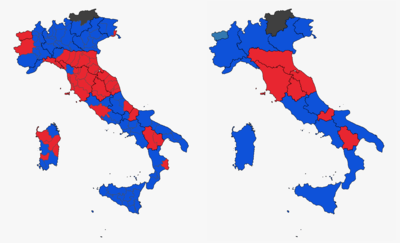Italian general election 2008
|
|
|||||||||||||||||||||||||||||||
|---|---|---|---|---|---|---|---|---|---|---|---|---|---|---|---|---|---|---|---|---|---|---|---|---|---|---|---|---|---|---|---|
|
|||||||||||||||||||||||||||||||
|
All 630 seats in the Chamber of Deputies and 315 seats (out of 322) in the Senate of the Republic |
|||||||||||||||||||||||||||||||
| Turnout | 78.12% | ||||||||||||||||||||||||||||||
|
|||||||||||||||||||||||||||||||

Election results maps for the Chamber of Deputies (on the left) and for the Senate (on the right). On the left, the color identifies the coalition which received the most votes in each province. On the right, the color identifies the coalition which won the most seats in respect to each Region. Blue denotes the Centre-right coalition, Red the Centre-left coalition, Light Blue, and Gray regional parties.
|
|||||||||||||||||||||||||||||||
|
|||||||||||||||||||||||||||||||
Silvio Berlusconi
People of Freedom
A snap general election was held in Italy on 13–14 April 2008. The election came after President Giorgio Napolitano dissolved Parliament on 6 February 2008, following the defeat of the government of Prime Minister Romano Prodi in a January 2008 Senate vote of confidence and the unsuccessful tentative appointment of Franco Marini with the aim to change the current electoral law. Under Italian law, elections must be held within 70 days of the dissolution. The voting determined the leader of Italy's 62nd government since the end of World War II. The coalition led by ex-Prime Minister Silvio Berlusconi from The People of Freedom party defeated that of former Mayor of Rome, Walter Veltroni of the Democratic Party.
On 24 January 2008 Prime Minister of Italy Romano Prodi lost a vote of confidence in the Senate by a vote of 161 to 156 votes, causing the downfall of his government. Prodi's resignation led President Giorgio Napolitano to request the president of the Senate, Franco Marini, to assess the possibility to form a caretaker government. The other possibility would have been to call for early elections immediately.
...
Wikipedia


